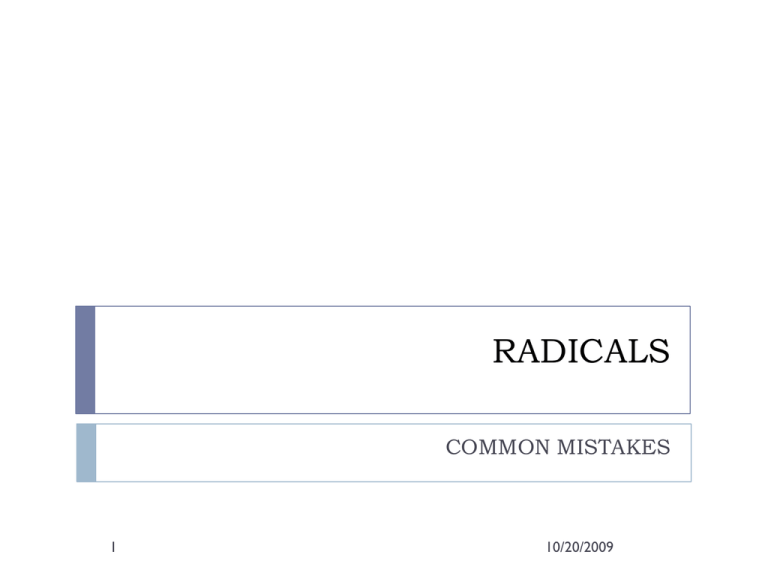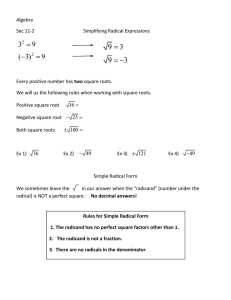RADICALS COMMON MISTAKES 10/20/2009 1
advertisement

RADICALS COMMON MISTAKES 1 10/20/2009 Radicals-Notation, Definition, and Simplifying How to Understand the Definition and Notation Notation: a n= root, = radical, a= radicand. Square root, n=2, but the two is NOT written (i.e. 16 ) 3 Cube root, n=3, (i.e. 8 ). Definition and Simplifying: n a requires a to be factored into repeating factors and for n repeating factors, one factor can be “pulled through” the radical: Examples: n=2 requires the factor to repeat twice n Common Mistakes Not correctly factoring into simplified form. Incorrect: 48 = 4 • 12 = 4 • 12 = 2 • 12 16 = 4 • 4 = 4 n=3 requiring the factor to repeat three times 3 3 8 = 2•2•2 = 2 Correct: 48 = 16 • 3 = 16 • 3 = 4• 3 2 Complete Manual: ..\Radical Review.docx To view; right click and open hyperlink 10/20/2009 Radicals-Negative Radicals How to Evaluate Negative Radicals Since a (where n is a positive integer,) implies only the positive roots, there are times when the radicand, a , can be negative. If the radicand, a, is negative, then it is defined only if n is a positive ODD integer. n Common Mistakes Trying to evaluate negative radicands when n is even. Confusing − 2 and − 2 . Forgetting the negative sign when evaluating radicals with POSITIVE ODD ROOTS. 3 − 8. Example: Simply Solution: Since n=3 is a positive odd integer, a=-8 is permissible. So, − 8 = − 2 • −2 • −2 = −2 . 3 3 Complete Manual: ..\Radical Review.docx To view; right click and open hyperlink 3 10/20/2009 Radicals-Multiplication/Division How to Multiply/Divide Radicals Multiplication a • b = ab Division n a a = b b n n Note: n must be the same and a and b must be defined such that n yields a Real solution. 4 Complete Manual: ..\Radical Review.docx To view; right click and open hyperlink Common Mistakes Not combining or separating radical expressions when simplifying expressions. Example 1: Simplify: 2 • 8 . Solution: = 2•8 = 16 = 4 Example 2: Simplify: Solution: = 27 = 9=3 3 10/20/2009 27 . 3 Radicals-Addition/Subtraction How to Add/Subtract Radicals Common Mistakes Note: Radicals can only be added/subtracted together if they have the and same root with the same radicand. Sometimes, radicals must be simplified before they can be combined. 5 Complete Manual: ..\Radical Review.docx To view; right click and open hyperlink Not reducing radicals to their SIMPLIFIED form before trying to add or subtract the radicals. Example 1: Simplify. 3 16 + 2 − 14 3 3 Solution: First, 3 16 = 3 8 • 2 = 3 8 • 3 which then substitutes to become … 2, = 2 2 + 1 2 − 14 3 3 = 3 2 − 14 3 3 10/20/2009 3 Radicals- Rationalizing How to Rationalize Radicals A radical is considered to be in proper form if there is no radical in the denominator( the bottom number in a fraction). To put a radical expression in proper form is called rationalizing. It involves multiplying the expression by a clever form of 1. It is the radical in the denominator that will indicate what that form will be. 6 Complete Manual: ..\Radical Review.docx To view; right click and open hyperlink Common Mistakes Choosing the incorrect clever form of 1. 4 . Simplify 7 Incorrect: Correct: 4 7 28 • = 7 7 7 7 4 7 4 7 • = 7 7 7 10/20/2009 Radicals- Conjugating Radical Expressions How to Conjugate Radical Expression Given a + b , the conjugate is a − b or visa versa. Conjugates are multiplied together which cancels out the radical because ( x + y )( x − y ) = x − y shows that the middle terms “fall out”. 2 2 Common Mistakes Using the “wrong” conjugate. Incorrectly multiplying the terms together. Simplify by rationalizing the 3 denominator: 4+ 2 . Incorrect: Conjugate is− 4 + 2 Correct: Conjugate is 4 − 2 So… 3 • 4 − 2 4+ 2 4− 2 3(4 − 2 ) 3(4 − 2 ) = = 14 16 − 2 7 Complete Manual: ..\Radical Review.docx To view; right click and open hyperlink 10/20/2009 Radicals- Solving Radical Equations How to Solve Radical Equations When solving equations involving radicals, the first idea is to isolate the radical onto only one side of the equation before attempting to solve the equation. Then, raise both sides to the power that is the reciprocal of the root. Now, the variable is to the first power and is in simplified form. Common Mistakes Not noticing the value of the root problem, resulting in solving for the wrong power. Not repeating the process of solving until the variable is to the first power. Example: Solve 3 − x = −6 for x. Solution: − x = −9 x=9 ( x) = 9 x = 81 2 8 Complete Manual: ..\Radical Review.docx To view; right click and open hyperlink 10/20/2009 2




